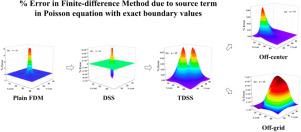Mathematics and Computers in Simulation ( IF 4.4 ) Pub Date : 2021-07-03 , DOI: 10.1016/j.matcom.2021.06.025 Nithin Kumar Goona 1 , Saidi Reddy Parne 1 , S. Sashidhar 2

|
The Finite-Difference Method (FDM) despite being old and simple is not being used as rigorously as its counterpart Finite Element Method (FEM) for solving partial differential equations. This study aims to examine and improve the accuracy of FDM by eliminating significant sources of error. Since an expression for exact potential from the most accurate Method of Moment (MoM) is available in 3-D electrostatics, the classical form of Poisson equation is chosen for this study such that the error due to boundary conditions can be eliminated. The error due to the source term in the Poisson equation is studied with a single source and different grid densities by applying FDM in 3-D. Since the error is only present in the immediate surroundings of the source, a Distributed Source Scheme (DSS) has been proposed to reduce error due to the source term. A modified DSS i.e., Truncated Distributed Source Scheme (TDSS) is applied for the practical implementation of DSS. The maximum error in FDM when the source term is present has been reduced from 8.151% to 0.00091% with DSS. With the application of TDSS, it is shown that the maximum error can be maintained well below 0.1% for truncation values n 15. The error due to source at off-center and off-grid positions was computed using TDSS and the maximum error is observed to be less than 0.05% and 0.01%, respectively. With off-grid error being low due to TDSS, it is shown that sources in TDSS can now take any position irrespective of grid nodes, which is forbidden in FDM with an average maximum error of 0.026%. It is also shown that DSS can also be used to find the charge distribution for a given potential distribution. While still maintaining the simplicity, improved accuracy and unrestricted source positions are achieved in FDM with exact boundary conditions using DSS.
中文翻译:

分布式源方案使用 3-D 有限差分法求解经典形式的泊松方程,以提高精度和不受限制的源位置
有限差分法 (FDM) 尽管古老而简单,但在求解偏微分方程时并没有像其对应的有限元法 (FEM) 那样严格使用。本研究旨在通过消除重要的误差源来检查和提高 FDM 的准确性。由于最精确的矩量法 (MoM) 的精确电位表达式可在 3-D 静电学中使用,因此本研究选择了泊松方程的经典形式,以便消除由边界条件引起的误差。通过在 3-D 中应用 FDM,使用单个源和不同的网格密度研究由泊松方程中的源项引起的误差。由于误差仅存在于源的紧邻环境中,因此提出了分布式源方案 (DSS) 以减少由源项引起的误差。一种改进的 DSS,即截断分布式源方案 (TDSS) 被应用于 DSS 的实际实现。使用 DSS,当源项存在时 FDM 中的最大误差已从 8.151% 降低到 0.00091%。TDSS 的应用表明,对于截断值 n,最大误差可以保持在 0.1% 以下15. 偏离中心和离网位置的源误差是使用 TDSS 计算的,观察到的最大误差分别小于 0.05% 和 0.01%。由于 TDSS 的离网误差较低,表明 TDSS 中的源现在可以采取任何位置而不管网格节点,这在 FDM 中是禁止的,平均最大误差为 0.026%。还表明 DSS 还可用于找到给定电位分布的电荷分布。在仍然保持简单性的同时,使用 DSS 在具有精确边界条件的 FDM 中实现了更高的精度和不受限制的源位置。











































 京公网安备 11010802027423号
京公网安备 11010802027423号